In Japanese, otokonoko 男の子 means "boy," literally "male child." This post, however, is about otokonoko 男の娘, "male girl," an Japanese anime slang for boys that look like girls, that translates to English as the anime slang "trap," or the gay slang "femboy."
Kinoshita Hideyoshi 木下秀吉
Urushibara Ruka 漆原るか
Astolfo アストルフォ
Totsuka Saika 戸塚彩加
Felix Argyle フェリックス・アーガイル
Kanzaki Hideri 神崎ひでり
Anime: Baka to Test to Shoukanjuu バカとテストと召喚獣 (Episode 3)
Anime: Steins;Gate (Episode 8)
Anime: Fate/Apocrypha (Episode 2)
Anime: Yahari Ore no Seishun Love Comedy wa Machigatteiru. やはり俺の青春ラブコメはまちがっている。 (Episode 3)
Anime: Re:Zero kara Hajimeru Isekai Seikatsu Re:ゼロから始める異世界生活 (Episode 12)
Anime: Blend S, ブレンド・S (Episode 10)
Definition
An otokonoko 男の娘 is a girl that's actually a boy. For all intents and purposes, the character is treated like just any other girl in the series. He's a heroine. Except that he's male.
Basically, the author draws a girl, but says it's a guy, and that's an otokonoko character.
Anime: Nanbaka ナンバカ (Episode 1)
- Context: the Mars symbol (♂) means male.
I'm not joking, that's literally what happens. Here's a quote straight from the creator of Bridget saying something of sort:
I had a spot for a cute character. I thought it would be too boring if the character was just cute, so I thought it would be interesting to make the character a guy.(asiaarts.ucla.edu)
Yep. That's about it. That's all there's to it.
Game: Guilty Gear XX
In moe 萌え anime, specifically CGDCT and harem genres, every heroine has a quirk, sometimes called a moe attribute. Some girls are unfriendly at first, tsundere ツンデレ, others wear glasses, meganekko メガネっ娘, and so on.
An otokonoko is a girl whose quirk is that she's a he. It's like a glasses girl, but instead of wearing glasses, she wears a penis.
Anime: Ore, Twintail ni Narimasu., 俺、ツインテールになります。 (Episode 10, Collage)
- Context: in this series, every villain character is associated with a particular moe attribute, and Spider Guildy has the otokonoko attribute.
The otokonoko character is generally treated like just another heroine, including getting featured in fanservice scenes and falling victim of common fanservice tropes, such as cosplay.
Anime: Baka to Test to Shoukanjuu バカとテストと召喚獣 (Episode 5, Stitch)
- Context: Hideyoshi cosplaying in a china dress, which got torn for some reason.
Despite being treated as a heroine, otokonoko characters count as a guy in gay ships, BL, yaoi やおい, typically taking the role of the uke 受け in a ship.
Exceptionally, some ships featuring an otokonoko character are called yuri 百合 instead, yuri being a term for lesbian fiction. For example:
- homo-yuri
ホモ百合
Gay yuri. A ship between two uke characters, like between two otokonoko characters.(dic.pixiv.net)- See also: types of seme and uke.
- giji-yurI
疑似百合
Pseudo yuri. A ship between a woman and an otokonoko character, or two otokonoko characters, that looks like yuri, but isn't.(dic.pixiv.net)
The otokonoko characters are often associated with the fujoshi 腐女子, "rotten girls," a niche audience that ships guys with guys.
In harem series, since multiple girls have to be interested in one guy somehow, it's typical for the guy to have a passive role, and the girls to make romantic moves and drag him around, having quirks that range from aggressive, or sometimes abusive, to perverted.
The otokonoko character, whose quirk is merely "male," often ends up being the most maidenly heroine by comparison. The otokonoko ends up being the cutest girl in the series, because the other girls all have issues, and aren't very cute at all.
Behind: Fujinomiya Neko 藤ノ宮寧子
The guy: Makabe Masamune 真壁政宗
Right: Shuri Kojuurou 朱里小十郎
Bottom: Adagaki Aki 安達垣愛姫
Anime: Masamune-kun no Revenge, 政宗くんのリベンジ (Episode 7)
- Context: the cast of your average harem anime, consisting of:
- A perverted fujoshi 腐女子, who ships guys with other guys.
- A perverted ojousama お嬢様, who walks around not wearing underwear.
- A pure, innocent trap, whose only flaw is that he's not very bright.
- A cruel man-hater, who has some serious personality issues.
The term otokonoko ultimately has to do with looks, and as such what counts as an otokonoko and what doesn't varies from person to person. Some people count as otokonoko:
- A male character that has long hair.
- A male character with a feminine face.
- A male character that crossdresses.
- An androgynous character.
- A character whose gender is unknown, canonically undisclosed.
Middle: Kurapika クラピカ
Right: Envy エンヴィー
Anime: Soul Eater (Episode 8)
Anime: Hunter x Hunter (1999) (Episode 3)
Anime: Fullmetal Alchemist, Hagane no Renkinjutsushi 鋼の錬金術師 (2003) (Episode 31)
Some people distinguish characters that normally look like a girl from those that only look like a girl when crossdressing, calling the latter not otokonoko but:
- josou-danshi
女装男子
Crossdressing guy.
Things get more complicated when you consider some otokonoko characters are always crossdressing, so they technically "normally look like a girl" because you never see them wearing male clothes.
Sexuality and Gender
In spite of being drawn like girls, otokonoko characters generally don't have a transgender identity, identifying as male, and they're generally not gay, either.
- Context: a guy confesses to his skirt-wearing "childhood friend," osananajimi 幼馴染, who's called Osana Najimi 長名なじみ.
- Najimi! なじみ!
- ore to tsuki-atte ku
俺と付き合ってく
Will you date wi—
- ~te-kureru ~てくれる - to do something for me, used when asking favors, "please."
- muri.
ムリ。
[No way.] (literary "impossible.") - boku, otoko dashi.
ボク、男だし。
I'm a guy.
An exception:
- Hasuta ハス太, from Haiyore! Nyaruko-san 這いよれ!ニャル子さん, who is gay for the male protagonist.
Sometimes, an otokonoko character presents themselves as female, and the fact they're an otokonoko character can be a spoiler.
Anime characters in general never canonically assert that they're cis or trans, although fans may assume a character is either due cisnormativity or circumstantial evidence, like transgender expression.
Most otokonoko characters express themselves femininely due to reasons beyond their control.
They're designed with a feminine body, and display feminine mannerisms unconsciously, end up having to crossdress for some reason, and like cute things like sweets and girly accessories as a matter of preference.
When it comes to things they have control over, they'll typically assert they're male.
In Japanese, some words and phrases are considered masculine, while others are considered feminine.
See female language for details.
Most otokonoko characters won't use feminine language, unless they're pretending to be a girl as a disguise.
By contrast, characters that are designed to be gay men or trans women (okama オカマ, newhalf ニューハーフ characters) will deliberately speak in feminine language. A subset used by LGBT people that is overly feminine is called onee-kotoba オネェ言葉, and people who use it onee オネェ.
Typically when a character is a trans woman, you'll know right away, because she'll tell you.
- Grell Sutcliff グレル・サトクリフ, from "Black Butler," Kuroshitsuji 黒執事, uses onee-kotoba and calls herself a woman.
Since otokonoko characters don't do this, one may assume they aren't designed as trans characters in first place.
One difference between one type of character and the other is that most otokonoko characters are underage, as anime character usually are, while most characters that are canonically trans female are adults.
- Criff Kei クリフ・ケイ, from Mugen no Ryvius 無限のリヴァイアス, is exceptionally underage and trans.
- Sugoroku Hitoshi, from Nanbaka, is an adult otokonoko character.
Wordplay
The word otokonoko 男の娘, "trap," is a wordplay on otokonoko 男の子, which means "boy," replacing the kanji for "child," ko 子, with the kanji for "girl," musume 娘.
This practice of spelling words in alternative ways is called ateji 当て字. This specific replacement normally occurs with words that contain the gender neutral ~ko morpheme to indicate that the "child" is female. For example:
- oyako
親子
Parent and child. (any gender.) - oyako
親娘
Parent and female child.
Parent and daughter. - oyako
母娘
Mother and daughter.- Spelled with the kanji for haha 母, "mother."
Such words are homonymous, they're pronounced the exact same way, even if they're written differently in text, in manga, which means if a character says:
Or:
- kare wa otokonoko
彼は男の子
He is a boy.
That can be reinterpreted as something like:
- boku wa otokonoko
僕は男の娘
I'm a trap.
As such, the ~ko ~娘 part is extremely important.
Anime: Outbreak Company (Episode 4, Collage)
- Context: Minori teaches Japanese culture to residents of another world.
- {daiji na} no wa koko
大事なのはここ
{The important [part]} is here. - {{mita} me wa onnanoko, karada wa otokonoko} no kyara wo sashite kou yobimasu
見た目は女の子、体は男の子のキャラを指してこう呼びます
[We] call [by this term] a character [whose] {appearance is a girl, [but] whose body is a boy}
- Context: Futaba Tae 双葉妙, who had previously confessed her love to Makabe Masamune 真壁政宗, becomes infatuated with series token trap character, Shuri Kojuurou 朱里小十郎, prompting a response from Masamune.
- chotto matte, souiu shumi?
ちょっと待って そういう趣味?
Wait a second, [you] [have] that sort of fetish?- shumi
趣味
A sort of thing one likes.
A hobby.
A fetish.
- shumi
- {{ore e} no ai wo katatta} kuchi wa?
俺への愛を語った口は?
[What happened to] the mouth [that] {spoke of love {toward me}}? (literally.)
Where is the person that said she loved me?- Are you the same person that said that?
- otokonoko to otokonoko wa betsu wa betsubara dakara!
男の子と男の娘は別腹だから!
[It] is because boys and traps are [different things]!- betsu-bara
別腹
A separate stomach.
Separate stomachs. (plural.) - Here used in the sense that her love for boys and her love for traps aren't the same sort of love.
- betsu-bara
- {{iya na} kakiwake shiteru} no ga me ni ukabu!
嫌な書き分けしてるのが目に浮かぶ!
[I have an unpleasant feeling that] {[you] are writing them differently}!- iya da
嫌だ
Unpleasant. Unwanted. Irking.
Used to refuse something you don't want. - kaku
書く
To write. - wakeru
分ける
To divide. To separate. To distinguish. - {iya na} kaki-wake
嫌な書き分け
A way to distinguish things in writing [that] {is unpleasant}. - me ni ukabu
目に浮かぶ
To float in one's eyes. (literally.)
To picture. To imagine something visual. - Since Masamune is a manga character, he can't READ the text of text balloons, which are spoken in-universe, but he imagines that Tae's speech would have the word otokonoko unpleasantly spelled in two different ways, one of them being "trap," if the speech were to be written.
- iya da
Otoko no Musume
The phrase otoko no musume 男の娘 is an alternative way to read otokonoko 男の娘, in order to disambiguate the "trap" anime slang the homonymous "boy" word, otokonoko 男の子.
It's also often a mistake. Applications that turn Japanese into romaji automatically tend not to have slangs, only common words, so the 男の娘 may get romanized as otoko no musume simply because the software doesn't know about the slang otokonoko.
Translation
There are various ways to translate otokonoko to English, and each of them doesn't quite match the word exactly.
vs. Trap
The Japanese anime slang otokonoko tends to be translated to the English anime slang "trap." All otokonoko characters are traps, but not all traps aren't otokonoko.
Characters that only look like a girl when crossdressing may not count as otokonoko, even if they count as traps.
Anime: Kuragehime 海月姫 (Episode 2, Stitch)
- Context: Kuranosuke doesn't look like a girl when he isn't wearing a wig, makeup, and female clothes, so he isn't an otokonoko.
Some people think "trap" is a transphobic slur, preferring using other terms, like otokonoko, to refer to the characters.
vs. Femboy
Sometimes, otokonoko is translated as "femboy" instead.
Femboy, literally feminine boy, isn't an anime slang, but a gay slang, which was originally a homophobic slur like sissy or wimp. A softer variant is femboi.(dictionary.com)
Given that otokonoko characters are boys that are feminine in one way or another, this translation seems pretty much right. However, "femboy" is a gay slang, so it tends to have sexual connotations.
In anime, otokonoko characters are boys that look like cute girls, not boys that look like sexy girls.
Although they may be drawn such way by a NSFW artist, it doesn't exactly fit the term as it's used toward characters shown on TV..
A more NSFW translation for "femboy" character would be:
- mesu-danshi
メス男子
Female boy. (literally.)- The word mesu 雌 means "female," but is normally only used toward animals, i.e. it's a biology term.
- It's vulgar to call a woman "a female" in this manner, as it would be dehumanizing by referring to her like an animal. It also has sexual connotations, as it's implied that the reductive purpose of a female is to copulate with a male, and vice-versa.
It lacks an exact definition, but one would guess such character would have to be both male and feminine in a sexual way somehow, e.g. with proportions that appear to be influenced by female hormones. The Pixiv dictionary cites Maraich as example.
Jada, ジャダ
Thatcher, サッチャー
Bjorn, ビョルン
Marion, マリオン
Maraich, マライヒ
Etrange, エトランジュ
Anime: Patalliro!, パタリロ! (Episodes 1, 2, 3, 4, 5, and 6, respectively)
- Context: an adaptation of a BL series targeted at a female audience. Of the six characters pictured, only Etrange is female, and four of the male characters blushed and fell in love at first sight upon seeing one of the male protagonists.
Male Daughter
The phrase "male daughter" is a mistranslation of otokonoko, presumably coming from a translator software or from someone who doesn't know the slang. The reason why this happens is basically:
- otoko da
男だ
To be male. - {otoko no}...
男の・・・
...[that] {is male} - otoko no musume
男の娘
A daughter [that] {is male}.
A male daughter.
The word musume 娘 means someone's "daughter," however, it can also refer to a young "girl."
- sono musume
その娘
That girl.
The daughter of that [person].
The slang otokonoko isn't about daughters. As we've seen before, we're only spelling it with musume 娘 to add the female gender to the gender neutral ko 子, "child," so even literally it would be translated as "male girl," not "male daughter."
Daughter of a Man
The phrases "daughter of a man" and "man's daughter" are other mistranslations of otokonoko.
These occur because when the no の particle comes after a noun, it creates a no-adjective, also known as the genitive case, which can be either copulative or possessive, e.g.:
- {sensei no} Tanaka
先生の田中
Tanaka [who] {is a teacher}.
The teacher Tanaka. - sensei no kuruma
先生の車
The car of the teacher.
The teacher's car.
The phrase "daughter that IS MALE" interprets otoko no as copulative, while "daughter OF A MAN" interprets it as possessive.
In Real Life
Both otokonoko and "trap" originate as anime slangs, but have been used by androgynous or feminine men and transgender women in real life to label themselves.
Since anybody can call themselves whatever they want, it's hard to imagine this has any meaning beyond applying the otokonoko or trap genre onto themselves.
Tropes
See the article on trap characters for tropes involving otokonoko characters.
Reverse
In Japanese, some words have their gender reversed when prefixed by gyaku 逆, "reverse," but the term otokonoko 男の娘 isn't one of such words. There's no such thing as gyaku-otokonoko, even though the term reverse-trap exists in English.
雄んなの子
The word onnanoko 雄んなの子, meaning "reverse-trap," was created in similar fashion as otokonoko 男の娘, "trap." Normally, otokonoko 男の子 means "boy," and onnanoko 女の子 means "girl," but the kanji were changed to create slangs.
In the case of onnanoko, the o 雄 kanji is usually found in the word osu 雄, which normally refers to "male" animals, as it is the male counterpart of mesu.
ボーイッシュ
The term booisshu ボーイッシュ, a katakanization of the English word "boyish," means basically "tomboy" in Japanese. It's used toward female characters that, literally, are boy-ish. They look and act a bit like boys.
The term booisshu ボーイッシュ is more popular than onnanoko 雄んなの子. If a character is called a reverse trap in English, they're probably going to be called boyish in Japanese.
References
- femboy - dictionary.com, accessed 2021-03-13.
- Anime Expo 2009: interview with Daisuke Ishiwatari and Toshimichi Mori - asiaarts.ucla.edu on web.archive.org, accessed 2019-04-27.
- ホモ百合 - dic.pixiv.net, 2021-05-11.
- 疑似百合 - dic.pixiv.net, 2021-05-11.
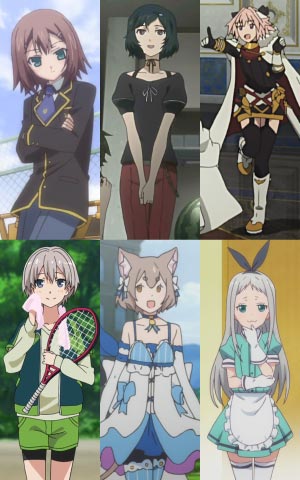
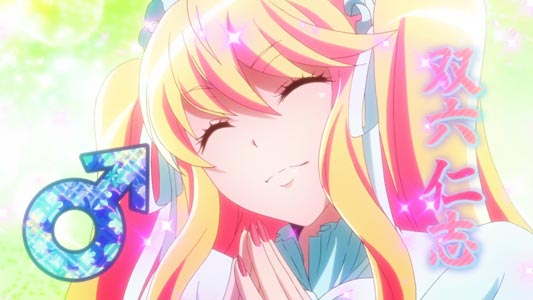
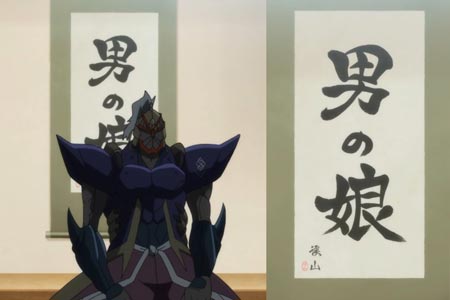
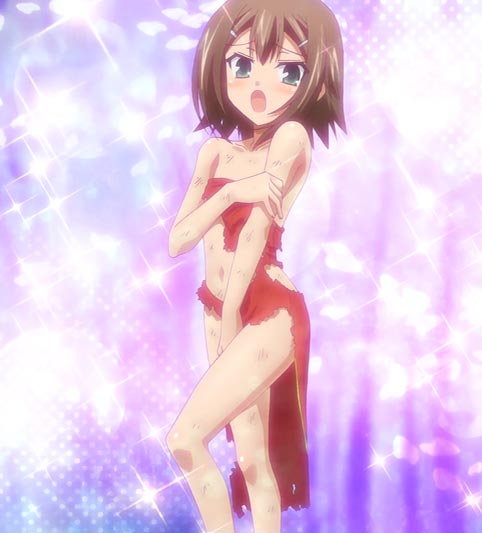
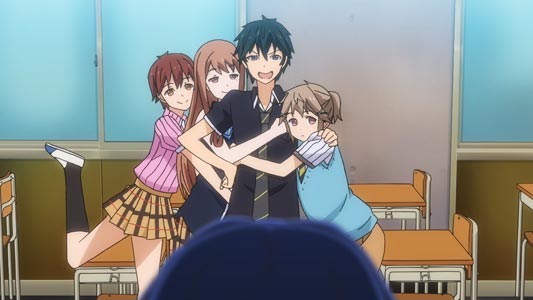
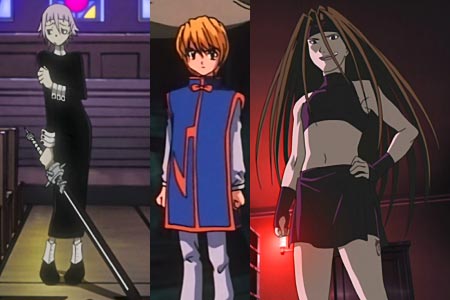
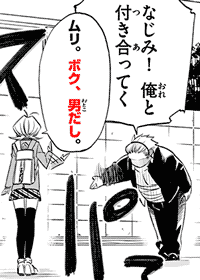
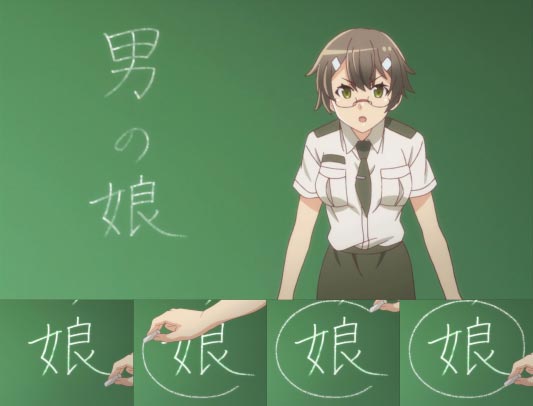
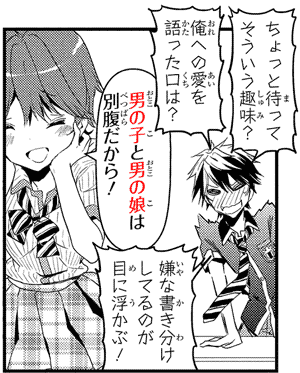
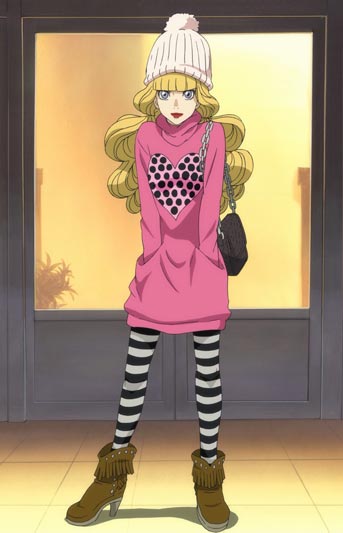
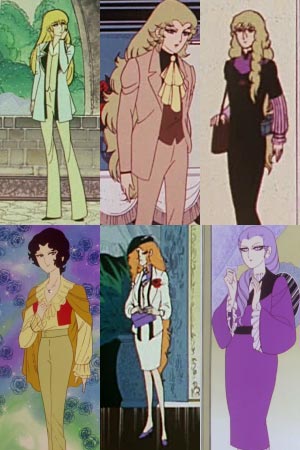
Okabe is insensitive and everyone knows it. Okabe is the one who said "daga otoko da" when referring to Luka. Mayuri always calls Luka Lukako. always. Okabe deserved the book smacking he got from Kurisu.
ReplyDelete